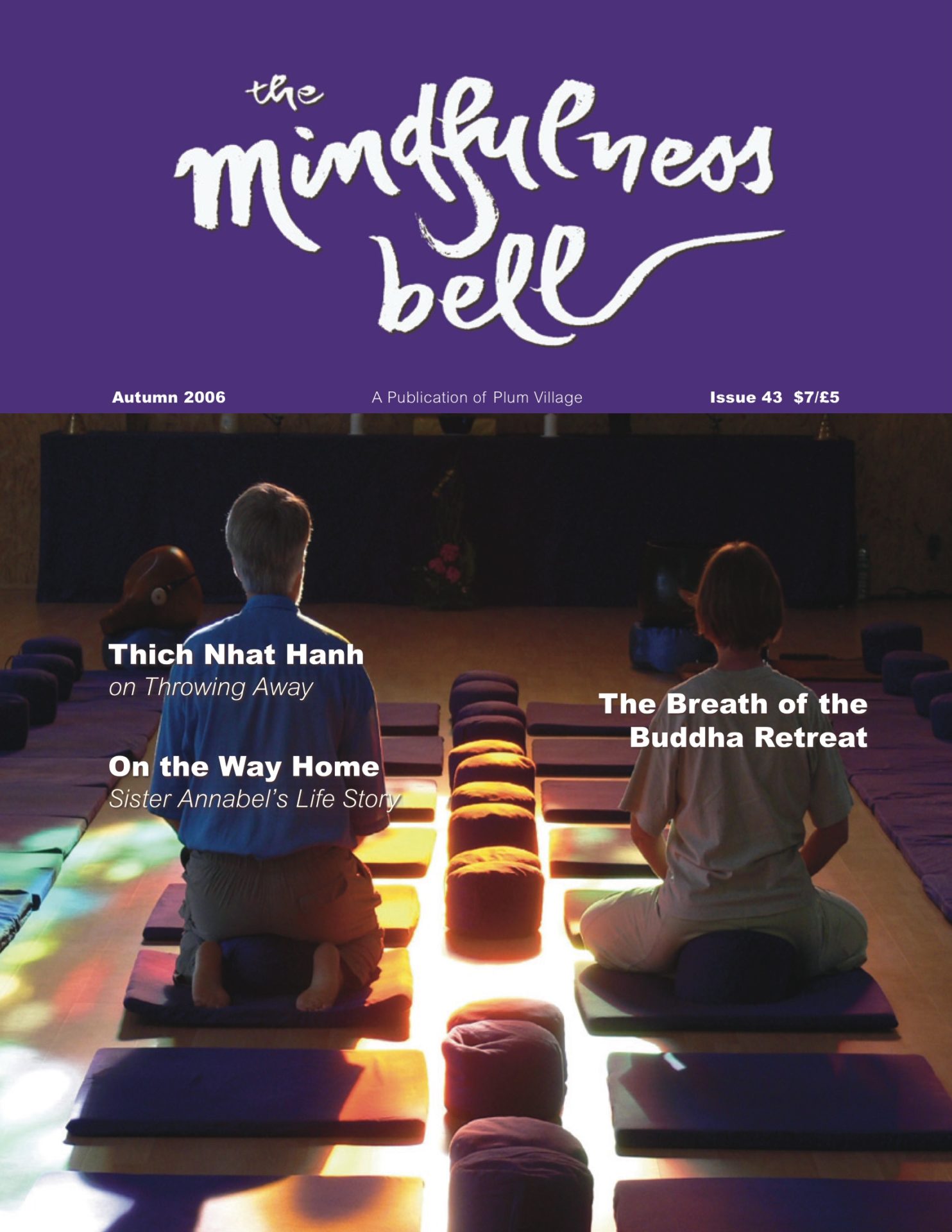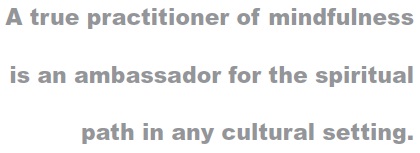
By Sister Annabel, True Virtue
Sister Annabel was one of Thây’s first students in the West. At Thây’s request, she is writing a memoir of her practice life; this is the second installment.
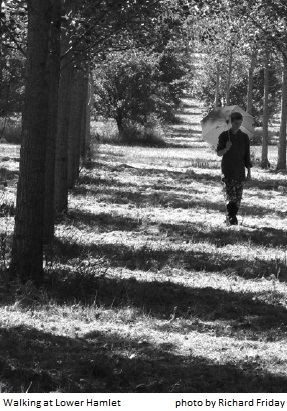
Thây and Sister True Emptiness [Sister Chan Khong] were so kind to me in my first years at Plum Village. They treated me like their own family, their niece,

By Sister Annabel, True Virtue
Sister Annabel was one of Thây’s first students in the West. At Thây’s request, she is writing a memoir of her practice life; this is the second installment.

Thây and Sister True Emptiness [Sister Chan Khong] were so kind to me in my first years at Plum Village. They treated me like their own family, their niece, their child. Can I ever repay them their kindness? Though they already had many things to take care of, they also took care of me. They understood, for example, that I liked to eat Western food, and they also introduced me to Vietnamese food.
Sister True Emptiness, out of great kindness, offered me many opportunities to eat Western food when I first came to Plum Village. Now it was some St. Paulin cheese, now a packet of muesli. We discovered a supplier of organic wheat flour some 70 kilometers from Plum Village, where we bought flour to make bread in our neighbor’s oven. Sister True Emptiness told me where I could buy milk from a neighboring farmer and taught me how to make yogurt.
From an early age we accustom ourselves to a certain kind of food. Not only our body but also our mind grows used to that food. Our parents and grandparents teach us to cook the food that they have learned to cook. If you come from Vietnam you like the taste of rice and the vegetables that grow in East Asia. If you come from France you are accustomed to bread at every meal. Thây often tells us that when the master Hsiuen Tsang traveled to India to bring the Buddhist scriptures to China he could no longer expect to eat the Chinese dumpling and had to be content with curry and rice. In a multicultural community we have the right to cook and eat the food of our motherland, when it is available, but we also need to be open to new dishes and even be willing to try new ways of cooking from time to time.
A Bridge in a Divisive World
Sister True Emptiness is truly a person of two cultures. You feel that she is as at home in the French culture as she is in the Vietnamese. Thây also is as gracious in other cultural settings as he is in his own. A true practitioner of mindfulness is an ambassador for the spiritual path in any cultural setting. Thây encouraged me to practice being at home in the culture of the country of my birth and also in the Vietnamese culture. Thây never encourages anyone to abandon their own spiritual or cultural roots but rather to be in touch with these roots in mindfulness. Cultures can complement each other and a true person of two cultures can be a bridge in a divisive world.
Sometimes Thây would offer me tea made with milk and sugar. Occasionally he would also make himself a cup of this British tea but at other times he would drink the Chinese tea to which he had always been accustomed, as I sipped the British kind. When Thây introduced me to Chinese tea, he taught me to fill the glass two-thirds full and when the glass was emptied, to inhale the fragrance that remained in the glass from the tea. That fragrance is the fragrance of the tea flower.
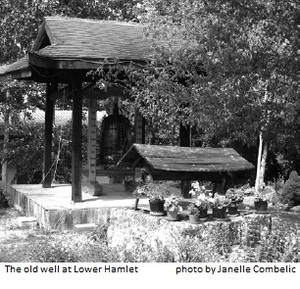
From Community to Sangha
At the end of 1986 Thây and Sister True Emptiness were away in Australia and the refugee camps of Hong Kong and the Philippines. That winter it snowed heavily and since in that part of France there is no equipment to clear the roads we were not able to leave the Lower Hamlet. The wild animals were very hungry and boar came nearby looking for food. We had collected just enough wood in the months before to keep ourselves warm but the pipes froze and we collected snow to melt and use for water. When we practice to follow our breathing in the present moment as our lives are going well, we have something to rely on in the winter of our lives when conditions are not what we should wish for. Life has its wonderful message of impermanence that encourages us to practice and helps us be grateful for everything that is available for us in the present moment.
We were a community of twelve living in the Lower Hamlet—myself, four young men newly arrived from the refugee camps, and in the Persimmon Building, a family from the refugee camp: father, mother, four children, and their uncle. The eldest was twelve and the youngest less than two. They made a living by growing Asian vegetables and selling them in Bordeaux. The father was an ordained member of the Order of Interbeing. At that time we could not yet call ourselves a sangha because we did not share the spiritual path as does a sangha. Thây and Sister True Emptiness loved us all and held us in their embrace of care and affection. They wanted us to practice every day as part of our ordinary daily living but somehow we were not there yet. Thây was very patient with us. Sister True Emptiness had instructed me to be as an elder sister to the four young men. I was to make sure that they studied French and recited the mindfulness trainings every week. This was not too easy for one of the young men who was not confident in his ability to learn French and enjoyed above all playing volleyball just at the time when the French class was happening.
When Thây came back from the tour of Southeast Asia and Australasia, he shared with me that Plum Village would become a practice center and the people who lived there would be united by their practice. I was very happy and reassured when I heard this and wondered how it would happen. When they were not traveling to teach the Dharma, or during the one-month summer opening for families, Thây and Sister True Emptiness lived in the hermitage. They would visit us from time to time. Sometimes the visit was unexpected and sometimes Sister True Emptiness would call us in advance to say that Thây would come and give a teaching. Everyone knew that Thây did not want us to drink wine or eat meat but there was no regulation. When they knew that Thây was coming all traces of wine and meat were hidden away. I never drank alcohol or ate meat myself but I did not need to tell tales to Thây; he seemed to know what was happening whether we told him or not.
Thây and Sister True Emptiness guided our practice; apart from Thây we were all lay practitioners. Thây asked me to think about a constitution for Plum Village to help Plum Village become a practice center. In the Fragrant Palm Leaves community in the south-central highlands of Vietnam, the practitioners under Thây’s guidance had not needed this kind of regulation because they all had a firm basis in the practice of Buddhism. Thây, like the Buddha, was not in a hurry to make regulations, but there came a point when, for the sake of the practice, it was necessary to do so. Basically our constitution held that those who lived in Plum Village followed the schedule of practice and studies, recited the mindfulness trainings, and abstained from meat, alcohol, and cigarettes. The final item of the constitution was that those who did not want to live in accord with the mindfulness trainings would be asked to leave; Plum Village would give them assistance to find a place to live and a way of earning a livelihood.
There were no hard feelings on the part of the four young men who left at this time. They felt that it was the right time to go and they were ready to take the next step in their life in France.
The Deep Practice of Organic Gardening
Under Thây’s guidance, I began to learn the practice of living in harmony. Unlike other members of my community, I had experience in organic gardening. To me it seemed the only sane way to produce vegetables and fruits. To the others it seemed a crazy idea. I was sure that Thây would support this idea but he was firm that there should be a consensus in the community. Only in retrospect do I see the wisdom of this. We all know how much Thây cares about the environment. Long before coming to Plum Village Thây had organized the Dai Dong conference in Sweden one year as an alternative to a governmental conference on the environment organized in South Africa. Many delegates to that official conference had a vested interest in not protecting the environment and that is why Thây and his friends saw the need for an alternative. So it was difficult for me to understand why he did not speak out in support of organic cultivation in Plum Village.
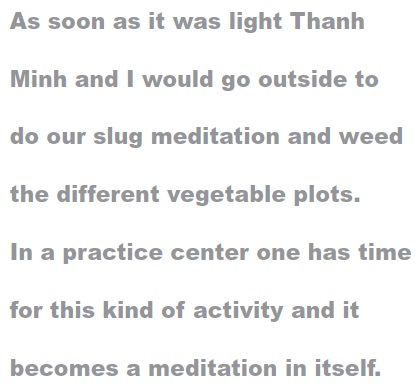
Thây said that all of us must sit together, discuss, and agree on how we were going to cultivate the land. During this discussion I was a minority of one. Thây suggested that I take a small plot of land and cultivate it organically. Others would see the results and then we could increase the size of the organic garden. This is entirely in the spirit of the Fourteen Mindfulness Trainings—we do not force others to accept our views, even though those views are Buddhist ones, and we allow people to decide; but we use compassionate dialogue to help people make the decision that is most beneficial to the community.
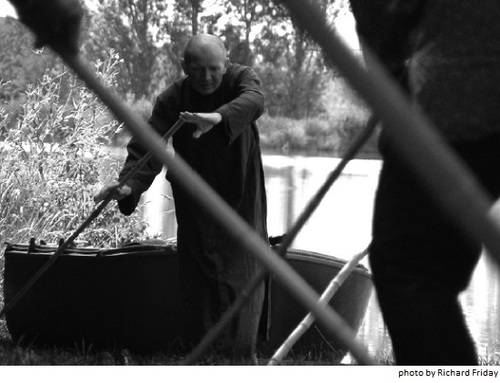
By this time I had been joined by another sister whose name was Thanh Minh. She was a refugee whom Sister True Emptiness had met on the tour of the Southeast Asian refugee camps and sponsored to come to France. Thanh Minh had spent time with a teacher in a temple in Vietnam so she knew about the temple way of life. Her arrival in Plum Village was a very happy moment for me. Together we could live and practice and work in mindfulness. And together we worked in the garden.
The plum trees planted in the Lower Hamlet had been donated by lay practitioners, many of them children. They knew that when the plums were harvested the proceeds from selling them would be sent to Vietnam to support the poorest families. We all felt responsible to our donors and wanted to produce the crop they expected of us. So we began slowly but surely. In the early morning we would examine the seedlings for slugs and gently put them in a tin and transport them to a meadow or the forest. We had plenty of uncultivated land around us where they could survive.
As soon as it was light Thanh Minh and I would go outside to do our slug meditation and weed the different vegetable plots. In a practice center one has time for this kind of activity and it becomes a meditation in itself. The garden is a wonderful place to practice. The greenhouse is like a meditation hall. The aroma of incense is the aroma of coriander leaves and mint and celery. The mind is the greenness of the plants and the discrimination of what is weed and what is vegetable; somehow the mind needs to discriminate between what is a positive and what is a negative thought. When Thây had first asked me if I wanted to stay on in Plum Village, I had asked him what I should do. Thây had said: “Be yourself and, if you like, plant a little mustard green to eat in the winter.”
Our next step in making an organic garden was to find out about organic fertilizers. The sales representative told us about bone meal and dried blood. We asked him where he acquired such materials. He said that the local abattoir [slaughterhouse] sold it to him. We did not feel we could participate in supporting the slaughter of animals. So we relied on planting nitrogen-fixing plants between the rows of plum trees, compost, and cow dung. Plum Village has cultivated organically for many years now.
Tofu as Teacher
One of the young men in the community had made and sold tofu and bean sprouts in the Hong Kong refugee camp and he taught me how to do this. The bean sprouts we made in a large old wine barrel—that region is part of the Bordeaux wine-producing land—nearly full of sawdust. The tofu we made by soaking the beans overnight, then they were ground in an electric grinder. We put the ground beans in a muslin sack and pressed them with water so that we had the milk. The first milk that we pressed out by kneading the sack was thick and creamy. Then we added more water and the milk was less creamy. The first milk was made into tofu and the second when cooked was kept for soy milk. When the creamy milk comes to the boil you add a tablespoon of calcium carbonate and miraculously the liquid gels. Then you press it into shape in a mold for several hours. The lid is held down by heavy stones. It was not always successful. Sometimes the gelling does not happen and there is little you can do with the resulting liquid. I never knew exactly why it was not successful but there must have been causes and conditions.
Mustard greens grew well in Plum Village. If you dropped seeds on uncultivated land they would germinate. If the plants were left to go to flower they would seed themselves. With so much mustard green we could make a pickle. Pickles also need to have the right conditions in order to be successful. Thây taught me how
to make mustard green pickle in the hermitage. To make pickles all you need is mustard green leaves, salt, and water. First you sterilize the ceramic or glass pots you will use to make the pickle in, because the presence of the wrong kind of bacteria will stop the proper pickling process and lead to a bad-smelling, mold-covered result. You do not need to cook the mustard greens, you just pour boiling water over them, having put a tablespoon of salt in the pot first. You press the mixture down with a heavy lid and leave it for three or more days, depending on how cold the weather is. You should not look at the pickle too early, because opening the lid can also cause foreign bacteria to come in.
The first time I made mustard green pickle, it did not work. I was disappointed just as when tofu failed. Somehow I learned from my mistakes. At first I think, “what a waste of material resources and time!” Then I look back and discover at what stage the process could have gone wrong. I compare myself or my actions of body, speech, and mind to the making of tofu or pickle. You could say that a disciple of the Awakened Ones is in the making.
There are actions of body, speech and mind that are not successful. They are not edible for others and they do not nourish myself. Thanks to the practice of recollection, when I think back on that action I feel an unpleasant feeling. That unpleasant feeling gives rise to mental attention. The mental attention, if it is appropriate, will give rise to the two beneficial mental formations of hri (humility) and apatrapya (shame). I feel ashamed because I know I have hurt someone by my words, deeds, or thinking. In humility I come to the other and apologize. That is how I learn and the next time the pickle will be more edible. I do not allow the bacteria of guilt to come into the ceramic pot because that bacteria will never allow the proper souring process to take place. Shame is not guilt. Shame means “I know I have made a mistake. I am sorry. I make the deep aspiration not to do or say it again.” Guilt is a regret that takes away my energy. It is the idea that I cannot stand up after I have fallen and the fault I have committed will always follow me without my being able to do anything about it.
Maybe I do or say it again. Then I know my aspiration was not followed up by enough mindfulness and concentration. So the old habit energies, like old bacteria sticking to the sides of the unsterilized pot, spoiled the pickle again. Again I express my regret and this time it is successful; a new habit energy has formed in the depths of consciousness.
Finally the pickle is pickled, the soy cream gels into delicious tofu.
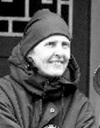
Sister Annabel, True Virtue, is abbess of Green Mountain Dharma Center, a four-fold sangha in Vermont.

